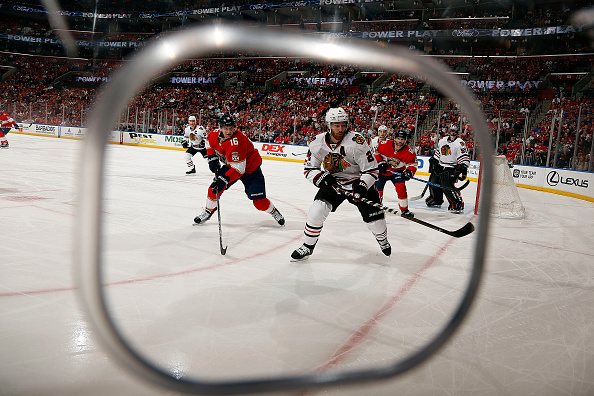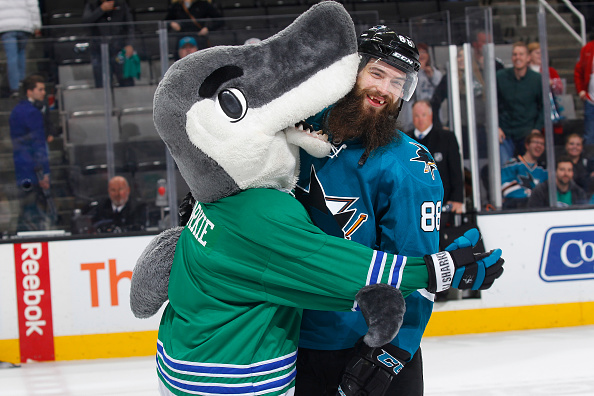2017 NHL Draft Guide: Five Winning Strategies

Published: Sep 01, 2017
 Five Winning Strategies
Five Winning Strategies
There is more than one way to win a fantasy hockey league, just as there is more than one way to score a goal on the ice. Some NHLers create a high shot volume every season, such as Boston Bruins' dependable veteran center Patrice Bergeron--who registered the third-most shots in the NHL (302) in 2016-17. Conversely, Montreal speedy winger Paul Byron actually tallied one more goal (22) than Bergeron (21) last season--despite registering only 96 shots on goal! Despite the goal-scoring similarities, are these two players equal in terms of fantasy value? No way. Bergeron, for one thing, produced 11 more assists than Byron last season. Secondly, his high shots total suggests he could repeat (or even better) his '16-17 numbers. In Byron's case, his outstanding shooting percentage appears to be less sustainable over the long run. Was Byron a one-year wonder? Perhaps. The bottom line is he will need to shoot the puck more in order to continue to trend upwards in fantasy hockey. Looking for high shot totals is just one of many good strategies to utilize when drafting your fantasy hockey roster. Here are five more:
1. Draft healthy, durable talent.
 Some fantasy owners are shocked when they do not win their leagues, but a glance at their roster reveals several injury-prone players may be the culprits. Florida Panthers center Aleksander Barkov is an immense talent entering his fifth NHL campaign and only turns 22 years old in September. He is primed for a breakout season in 2017-18 and should be drafted RELATIVELY early in most leagues this year. The term 'relatively' is used here because he is the type of player who should never be over-drafted (i.e. selected a bit earlier than he should have been taken). That is because a quick glance at his injury history reveals that Barkov has missed an average of 19 games so far in his NHL career. Conversely, new Toronto Maple Leafs veteran forward Patrick Marleau will turn 38 in September and is entering his 20th NHL campaign (his first outside of San Jose). He produced only six fewer points than Barkov in '16-17 and has not missed a regular-season game since 2008-09. So, should Marleau be selected before Barkov? Absolutely not. But durability should always be factored into draft-day decisions. A team littered with injury-prone talent is a recipe for fantasy disaster.
Some fantasy owners are shocked when they do not win their leagues, but a glance at their roster reveals several injury-prone players may be the culprits. Florida Panthers center Aleksander Barkov is an immense talent entering his fifth NHL campaign and only turns 22 years old in September. He is primed for a breakout season in 2017-18 and should be drafted RELATIVELY early in most leagues this year. The term 'relatively' is used here because he is the type of player who should never be over-drafted (i.e. selected a bit earlier than he should have been taken). That is because a quick glance at his injury history reveals that Barkov has missed an average of 19 games so far in his NHL career. Conversely, new Toronto Maple Leafs veteran forward Patrick Marleau will turn 38 in September and is entering his 20th NHL campaign (his first outside of San Jose). He produced only six fewer points than Barkov in '16-17 and has not missed a regular-season game since 2008-09. So, should Marleau be selected before Barkov? Absolutely not. But durability should always be factored into draft-day decisions. A team littered with injury-prone talent is a recipe for fantasy disaster.
2. Corner the market at 1 position.
 Real General Managers often suggest that they take the 'best player available' at the draft, regardless of position. Fantasy GM's can use that premise and go even further to corner the market at a valuable position. In fantasy hockey, that usually means goaltenders. However, high-scoring defensemen can also be a premium position. Imagine if one fantasy GM decided to draft Ottawa's Erik Karlsson, San Jose's Brent Burns and Nashville's P.K. Subban for the same team. It could pay huge dividends if said GM is later offered great talent to trade in exchange for one of his stud D-men. Or, said GM could choose to keep his three blueline assets and try to fill out the rest of his roster with serviceable talent at deeper positions. Either way, this astute fantasy General Manager has cornered the market on elite fantasy defensemen and should be in position to benefit from it. The main drawback with this strategy is the old adage, “it takes two to tango”. Sometimes, fantasy leaguers will play hardball when negotiating trades. This strategy should be used only by experienced, savvy fantasy leaguers.
Real General Managers often suggest that they take the 'best player available' at the draft, regardless of position. Fantasy GM's can use that premise and go even further to corner the market at a valuable position. In fantasy hockey, that usually means goaltenders. However, high-scoring defensemen can also be a premium position. Imagine if one fantasy GM decided to draft Ottawa's Erik Karlsson, San Jose's Brent Burns and Nashville's P.K. Subban for the same team. It could pay huge dividends if said GM is later offered great talent to trade in exchange for one of his stud D-men. Or, said GM could choose to keep his three blueline assets and try to fill out the rest of his roster with serviceable talent at deeper positions. Either way, this astute fantasy General Manager has cornered the market on elite fantasy defensemen and should be in position to benefit from it. The main drawback with this strategy is the old adage, “it takes two to tango”. Sometimes, fantasy leaguers will play hardball when negotiating trades. This strategy should be used only by experienced, savvy fantasy leaguers.
3. Don't fall in love with the fresh faces!
 There is probably no more polarizing fantasy hockey player than the first-year rookie. Many fantasy leaguers love rookies. They take them early. They take them often. They are what is fresh and new about the upcoming NHL season, so rookies are popular picks in virtually all league formats. Last season, selecting the likes of Auston Matthews, William Nylander and Mitchell Marner of the Maple Leafs, Patrik Laine of the Jets or Zach Werenski of the Blue Jackets probably enhanced every fantasy leaguer's title hopes immensely. However, beware of drafting too many freshmen in fantasy hockey. This season's first-year crop is not expected to have as big of an impact as the '16-17 freshman class, and the risk remains very high. Perhaps the most intriguing 'rookie' for 2017-18 is Vegas Golden Knights center Vadim Shipachyov (who is not a rookie at all, technically). The 30-year-old Russian is too old to be in contention for the NHL's Calder trophy (rookie of the year) but might lead all first-year NHLers in scoring. That said, be prudent with ANY player who has never played an NHL game.
There is probably no more polarizing fantasy hockey player than the first-year rookie. Many fantasy leaguers love rookies. They take them early. They take them often. They are what is fresh and new about the upcoming NHL season, so rookies are popular picks in virtually all league formats. Last season, selecting the likes of Auston Matthews, William Nylander and Mitchell Marner of the Maple Leafs, Patrik Laine of the Jets or Zach Werenski of the Blue Jackets probably enhanced every fantasy leaguer's title hopes immensely. However, beware of drafting too many freshmen in fantasy hockey. This season's first-year crop is not expected to have as big of an impact as the '16-17 freshman class, and the risk remains very high. Perhaps the most intriguing 'rookie' for 2017-18 is Vegas Golden Knights center Vadim Shipachyov (who is not a rookie at all, technically). The 30-year-old Russian is too old to be in contention for the NHL's Calder trophy (rookie of the year) but might lead all first-year NHLers in scoring. That said, be prudent with ANY player who has never played an NHL game.
4. Don't forget the forgotten.
 Every NHL season, players who would have been keys to success for many fantasy leaguers get injured for lengthy stretches. They essentially become non-factors and are somewhat forgotten for awhile in the hockey world. Those same players make a comeback the following campaign, though, and can be valued draft picks in most league formats. Tampa Bay Lightning captain Steven Stamkos is always a threat to score the most goals every campaign. Last season he was reduced to only 17 games due to injury, but still racked up nine goals and 20 points. 'Stammer' is back in 2017-18, so do not forget about him and his elite production (only superstars Connor McDavid and Sidney Crosby registered a better points-per-game average than Stamkos in '16-17) Unfortunately, not every player returning from injury has Stamkos's fantasy value and upside. So, the best strategy is to pick and choose which comeback players are worth the risk. Too many of these types may not be a good thing (see Five Winning Strategies, No. 1), but a few talented NHLers will likely slip through the cracks.
Every NHL season, players who would have been keys to success for many fantasy leaguers get injured for lengthy stretches. They essentially become non-factors and are somewhat forgotten for awhile in the hockey world. Those same players make a comeback the following campaign, though, and can be valued draft picks in most league formats. Tampa Bay Lightning captain Steven Stamkos is always a threat to score the most goals every campaign. Last season he was reduced to only 17 games due to injury, but still racked up nine goals and 20 points. 'Stammer' is back in 2017-18, so do not forget about him and his elite production (only superstars Connor McDavid and Sidney Crosby registered a better points-per-game average than Stamkos in '16-17) Unfortunately, not every player returning from injury has Stamkos's fantasy value and upside. So, the best strategy is to pick and choose which comeback players are worth the risk. Too many of these types may not be a good thing (see Five Winning Strategies, No. 1), but a few talented NHLers will likely slip through the cracks.
5. He shoots, he scores! But...
Hockey legend Wayne Gretzky once proclaimed: “you miss 100 per cent of the shots you don't take.” Some fantasy leaguers take what the 'The Great One' says seriously and seek out players with a high shot volume. It does make sense to pick players who shoot the puck a lot in fantasy hockey, especially in leagues where bonus fantasy points are given to the shots on goal statistic. If a fantasy leaguer's roster leads everybody else in shots, there is a pretty good chance for fantasy contention. Earlier, we used the examples of Patrice Bergeron and Paul Byron to reflect the benefits of volume shooters versus high shooting percentages. However, there are times when the opposite is also true. Ageless San Jose playmaker Joe Thornton only shot the puck on goal 81 times last season but still managed to contribute 50 points in 79 games. Meanwhile, Columbus power forward Boone Jenner registered 211 shots on goal last season in all 82 games--but produced only 34 points. Some players are just natural point producers, such as Thornton, and those usually take precedence over harder workers. Usually.
